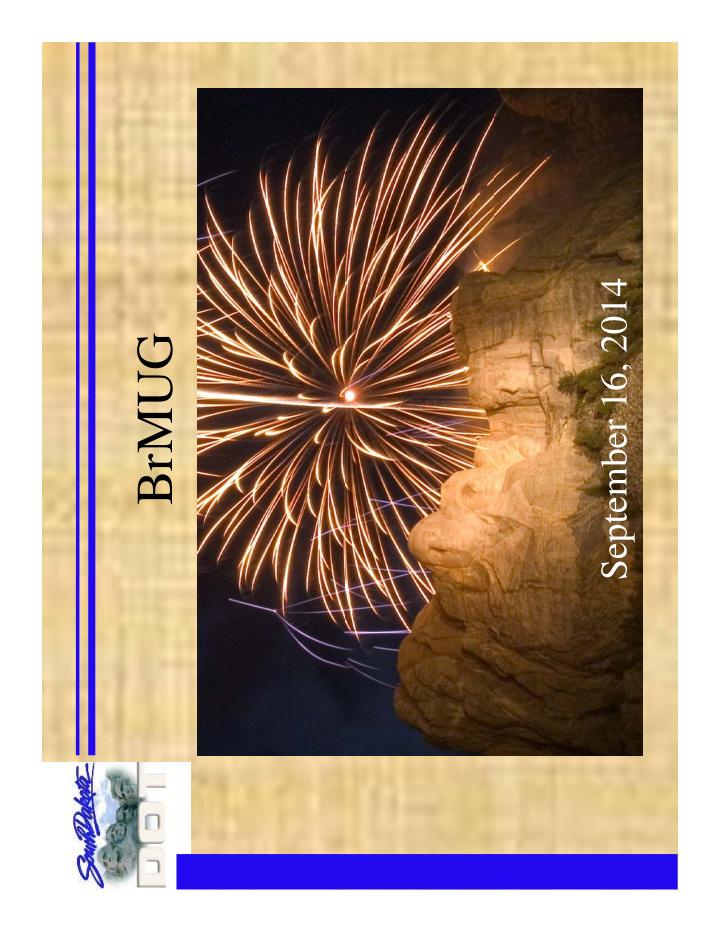



September 16, 2014 BrMUG
SD Bridge Inventory Statistics
Number of NBIS Structures in SD (As of March 2014) 1797 State Owned (SDDOT) Structures – 1260 bridges – 537 culverts 3953 Local Government Structures – 3145 bridges – 808 culverts
State vs. Local Government Inventory (LG) • Number: LG bridges, about twice as many • Deck Area: State bridges, about 1-1/2 times as much • Traffic: State bridges, about six times more
State vs. Local Government Inventory (LG) Sq Ft of Deck Area of Bridges 40% State LGA 60%
Typical State Owned Bridge • About 8,300 sq ft • About 210 ft long by 40 ft wide • Average year built is 1970
Bridge Age Distribution
Misc. Bridge Info • Longest Bridge – – Platte-Winner bridge on SD 44 – 5656 ft long and 171,354 sq ft of deck area • 7 Missouri River Bridges in SDDOT Inventory – Total 904,621 sq ft of deck area – Average length = 3,350 feet long – Account for about 9% of state bridges by deck area
Platte – Winner Bridge
Condition Status of South Dakota Bridges
Bridge Condition Measures • NBIS Federal Sufficiency Rating • Deficiency Classification (Structurally Deficient / Functionally Obsolete) • Health Index
Federal Sufficiency Rating Average Sufficiency Rating Index - State Bridges 100 98 96 94 Sufficiency Rating 92 89.7 89.6 89.3 89.7 89.5 89.4 89.5 90.6 89.1 90 88.4 88.6 88 86 84 82 80 2002 2004 2006 2008 2010 2012 2014 2016 Year
Deficiency – State Owned 4% 5% 91% Structurally Deficient Functionally Obsolete Not Deficient
Structural Deficiency Number of Structurally Deficient Structures (SDDOT Owned) 250 206 206 200 150 127 144 119 100 85 79 104 68 89 86 73 74 69 50 0 2000 2002 2004 2006 2008 2010 2012 2014 2016
Structural Deficiency • MAP-21 requires NHS bridges to have less than 10% by deck area to be Structurally Deficient – SDDOT is at 4.4%
Health Index 100.0 95.0 90.0 85.0 Health Index (0 - 100) 80.0 75.0 70.0 65.0 60.0 55.0 50.0 2003 2004 2005 2006 2007 2008 2009 2010 2011 2012 2013 2014
SD Bridge Management
Bridge Project Priorities • Protection of bridge deck/slabs • Minimize risk – scour countermeasures • Waterproof Joints • Upgrade bridge rail for safety • Replace or repair deteriorated elements • Replace structures when needed • Coordination with mainline projects
Bridge Preservation Practices • Rigid concrete overlay program for decks with black resteel (ongoing since 70’s) • Deck joint retrofitting to eliminate or better waterproof existing joints (also since 70’s) • Routine deck crack sealing (epoxy) • Thin polymer deck overlays (typically two coats of epoxy with broadcast aggregate) • Fatigue retrofitting of category E details on steel superstructures • Patching and protection of substructure units
New Bridge Design Longevity Practices • Jointless deck design with integral abutments (ongoing since 70’s) • Increased top clear cover (2 ½”) and use of ECR type deck resteel (since late 70’s) • Silane sealer deck application @ completion of construction • Stainless and dual coated rebar (metalized + epoxy coated) considered on limited basis
Bridge Project Programming • Inspector recommendations • Region/Area recommendations • Guidelines based upon proven standard bridge preservation practices • Bridge Management System (BMS) recommendations • Coordination with other projects for timing
Bridge Programming Considerations • Balance work/needs with available funds • Coordinate with grading/surfacing projects • Cost effectiveness of structure work Life cycle cost analysis methods
Programmed Spending Levels (average per year on State structures) • Interstate 3R – varies around $8 - 10 million • Bridge Program - $15.5 million – Includes structure replacement, rehabilitation and preservation projects • Other - Variable depending on number of structures included in grading and resurfacing projects.
BMS Capabilities (Pontis/BrM) • Inventory & Inspection Database • Performance Implications of Investment & Preservation Strategies – Given specified budget, estimate future health index • Generate Candidate Bridge Projects • Develop Project Scope of Work
SDDOT History with BrM • Been active with AASHTO products of Pontis and now Bridge Management since mid-1990’s • Some initial work in Pontis 2.0 • Production with Pontis 3 in 1997 • Developed element deterioration models • Been using Pontis as part of project planning and programming • Have entire STIP and all past projects in the application
SDDOT Future BrM • Migration of CoRe Elements to 2013 AASHTO Elements • Migration from Sybase to SQL Server database • Migration from Pontis 4.4.3 to Bridge Management 5.2.1 SP2
Questions?
Recommend
More recommend